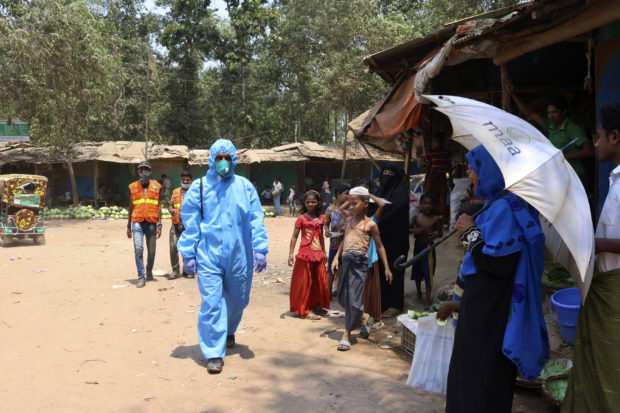
In this April 15, 2020, file photo, a health worker from an aid organization walks wearing a hazmat suit at the Kutupalong Rohingya refugee camp in Cox’s Bazar, Bangladesh. Authorities on Thursday, May 14, 2020, reported the first coronavirus case in the crowded camps for Rohingya refugees in southern Bangladesh, where more than 1 million refugees have been sheltered, a Bangladeshi official, and the United Nations said. (AP Photo/Shafiqur Rahman, File)
DHAKA, Bangladesh — The first coronavirus case has been confirmed in the crowded camps for Rohingya refugees in southern Bangladesh, where more than 1 million refugees are sheltered.
The person from the Rohingya community and a local person who lives in the Cox’s Bazar district who also tested positive have been isolated, Mahbub Alam Talukder, the country’s refugee commissioner, said Thursday.
Teams have been activated for treatment of the patients as well as tracing people they may have encountered and quarantining and testing of those contacts, Louise Donovan, a spokeswoman for the U.N. refugee agency, told The Associated Press.
Nationwide, Bangladesh has confirmed 18,863 cases, including 283 fatalities. But the toll is thought to be higher since adequate testing facilities are a challenge in the South Asian nation of 160 million people.
Aid workers have been warning of the potential for a serious outbreak if the virus spread into the densely crowded camps. Donovan said Thursday that 108 Rohingya refugees in Cox’s Bazar have been tested for the new coronavirus since the beginning of April.
With about 40,000 people per square kilometer (103,600 per square mile) living in plastic shacks side by side, the 34 camps have more than 40 times Bangladesh’s average population density. Each shack is barely 10 square meters (107 square feet) and many are overcrowded with up to 12 residents.
Donovan last month said radio, video, and other messages in Rohingya, Burmese, and Bengali languages explained to camp residents how the virus spreads, how people can protect themselves, the symptoms, and how to seek care if they became ill. Health workers within the camps had been trained on prevention and control, including the appropriate use of personal protective equipment, she said.
The U.N. and the government said about 1,200 beds for isolating and treating COVID-19 patients were being readied just outside the camps at Ukhiya and Teknaf in Cox’s Bazar. A plan was also underway for an additional 1,700 beds in cooperation with the International Organization for Migration, UNICEF, and Save the Children International.
Aid agencies and rights groups have also been demanding Bangladesh’s government withdraw restrictions on using mobile phones and internet in the camps. Authorities had suspended internet use inside the camps for security reasons, and recent reports said armed groups among the refugees were allegedly involved in kidnapping, smuggling of drugs and seeking ransom.
Daniel P. Sullivan, a senior advocate for Human Rights of the Refugees International, said the restrictions were holding back vital information.
“The lack of access to accurate information is fueling misinformation, and rumors abound in the camps that COVID-19 is always fatal or that the faithful will be safe,” Sullivan said in a statement.
Most of the Rohingya have fled Myanmar since August 2017, when Myanmar’s military launched counterinsurgency operations in response to rebel attacks. Security forces have been accused of mass rapes, killings and burning thousands of homes.
Authorities in Myanmar have long considered the Muslim Rohingya to be migrants from Bangladesh, even though their families have lived in the Buddhist-majority country for centuries. Nearly all have been denied citizenship since 1982, effectively rendering them stateless. They are also denied freedom of movement and other basic rights including education.